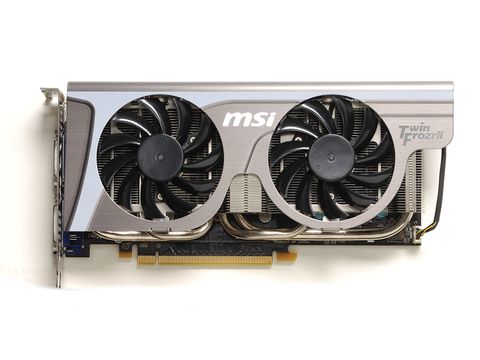TechRadar Verdict
Pros
- +
Decent price
- +
Good SLI performance
Cons
- -
Lags behind vanilla HD 6950
- -
Two-way is the only way
Why you can trust TechRadar
Just as the GTX 570 was replacing the GTX 480, leaving the GTX 580 out on its own at the head of the single-GPU pack, here we've got the GTX 560 Ti retiring the GTX 470, not the GTX 460.
Yes, that's a lot of numbers, but it does make sense, especially when you look at the performance of those GTX 460s, even in today's market. It would make no sense for Nvidia to kill off one of the best cards it's launched since the halcyon days of the 8800 GT.
But it's not quite as simple as just being another transistor-level tweak of the GTX 470 design. The GTX 560 Ti is more of a halfway house between the GTX 470 and GTX 460. It's got 64 less CUDA cores and eight less ROPs than the former.
To make up for this shortfall in GPU spec, it comes out of the box with the fastest core clockspeed we've seen in an Nvidia GPU since the FX 5xxx series, many moons ago. With a core clockspeed of 822MHz, it's pushing the upper limits of what the Fermi architecture can realistically manage. As such, there's not a huge amount of headroom left in the GPU for those overclocking folk out there.
Back to basics
At stock speeds, though, it's still a decent chip, and sits perfectly as the bridge card between the GTX 570 and GTX 460. That's all well and good so long as you keep AMD out of the equation, and that's something we just can't ignore.
Of course, it's that HD 6950 that makes things difficult for the GTX 560 Ti. But we're not talking about all the unlocking fun that can be had with AMD's second-tier card. In its traditional stock trim, the HD 6950 had the GTX 560 Ti pegged on all counts, bar the heavily Nvidia-centric DiRT 2 and Lost Planet 2 benchmarks. That chunky 2GB frame buffer on the HD 6950 gave it the edge, especially in our Metro 2033 test.
In SLI, though, the GTX 560 Ti started to show some promise. For the same price as a GTX 580, a pair of GTX 560 Tis in SLI gave us much better performance in most situations. Only that evil Metro 2033 test, with its heavy tessellation use, put clear air between the two setups.
Benchmarks
DirectX 11 tessellation performance
Heaven 2.5 FPS: Higher is better
Single: 13.2
SLI: 26.8
DirectX 11 gaming performance
Metro 2033 FPS: Higher is better
Single: 2
SLI: 2
DirectX 11 gaming performance
Aliens vs. Predator FPS: Higher is better
Single: 18
SLI: 35
DirectX 11 gaming performance
Lost Planet 2 FPS: Higher is better
Single: 24
SLI: 43
DirectX 11 gaming performance
DiRT 2 FPS: Higher is better
Single: 53
SLI: 99
DirectX 10 gaming performance
Just Cause 2 FPS: HIGHER IS BETTER
Single: 25
SLI: 44
But, then again, for the same price, a pair of HD 6950s will take the advantage straight back and leave the GTX 560 Ti sitting in the also-ran category. Then there's the fact that, down this low on Nvidia's inventory list, you can forget about three or four-way SLI, because it limits the bridge connectors on the PCBs south of a GTX 570.
However, on an HD 6950, you can go all the way up to four-way CrossFireX. While it's true that you'll start to get some severely limited returns on the extra cards past two-way, it's still a compelling performance setup.
So the GTX 560 Ti remains a decent card, and has a firm place in the Nvidia lineup. But sadly for the green team, that AMD incredi-card, the HD 6950, has things sewn up at this price point.
Follow TechRadar Reviews on Twitter: http://twitter.com/techradarreview

How to watch Liège-Bastogne-Liège 2024: live stream men's cycling online from anywhere

A key Apple app is rumored to be getting a major upgrade in macOS 15

Intel's formidable 288 core CPU now has a proper family name — Granite Rapids and Sierra Forest are Xeon 6 processors but is it just becoming too confusing?
